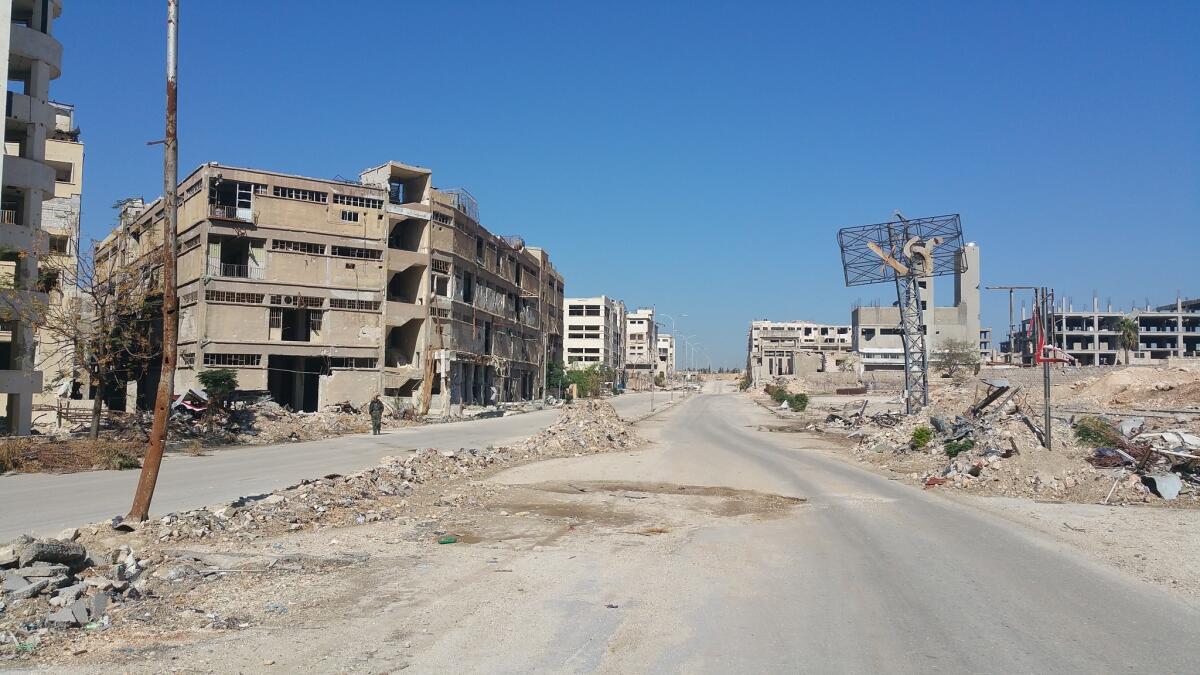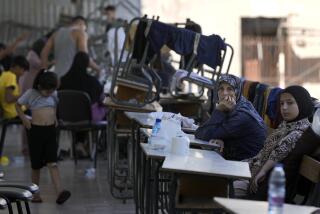Aleppo was Syria’s factory floor. Now it’s in ruins and business leaders wonder if it’s safe to rebuild

Reporting from Aleppo, Syria — When Moustafa Kawaie entered Layramoun, an industrial zone northwest of the Syrian city of Aleppo that was reclaimed by the government in July, he rushed to inspect his textile factory.
”I entered a few hours after the Syrian army did, but in the beginning I couldn’t find where my factory was,” Kawaie said last week, as he trudged along a rubble-filled thoroughfare cutting through Layramoun. It had been several months since the area was wrested from opposition forces.
Aleppo was once the industrial and financial heart of Syria, a city of 3 million people whose factories churned out textiles and pharmaceuticals and processed agricultural goods. Layramoun alone was home to approximately 1,600 companies, according to Kawaie. But four years of civil war between rebels and forces loyal to President Bashar Assad have silenced the factories and brought ruin to the city.
Although much of it is now back in the Assad government’s hands, business owners are wondering whether it is time to rebuild — and whether the city can ever regain its economic might.
As Kawaie looked around the area where his factory once stood, he saw no structure that was free of scars. Every inch of concrete appeared to have been nibbled by bullets and shrapnel. Chunks of concrete hung from rebar cores rising from the ground like so many trees. Airstrikes and heavy artillery shelling had caused some buildings to collapse, the floors stacked atop one another like fallen houses of cards.
“You have a memory of a place, and then when you return you see all the destruction,” he said. “It was a big shock.”
Elsewhere around Aleppo, one sees the carnage writ large: Overturned train cars and buses sit atop berms of sand and industrial detritus that line the road entering the city’s government-held areas. Even the stone pathways of the old quarter, home to a majestic citadel with a reigning view of the city, are lined with vertical, three-story-tall corrugated metal strips, a modern barricade amid ancient fortifications.
The city, divided since 2013 between government and opposition sectors, was the focal point of intense fighting this month.
The rebels mounted an offensive aimed at breaking a months-long blockade on their bastion in the eastern part of Aleppo, estimated to have anywhere from 200,000 to 350,000 people, according to aid groups.
They peppered government-held western Aleppo with rocket and mortar fire, while Islamist rebels dispatched suicide bombers with explosive-filled tanks to punch through government lines. But the government, backed by Russian air power, was able to solidify its grip on western Aleppo.
On Sunday, the government sent an ultimatum to eastern Aleppo, giving rebels 24 hours to evacuate or face a nine-pronged attack that “will be a surprise in strength and place and time.”
Aleppo’s importance, according to former Syrian Economic Minister Humam Jazaeri, comes from its production of what he called “intermediate goods.”
“In the value chain of the Syrian industry, it formed the building blocks in textiles, plastics, engineering industries and pharmaceuticals,” Jazaeri said.
“So for example, I produce clothes and textiles products in areas around Damascus, but I buy the cloth from Aleppo.”
But the war crippled much of that production.
“We used to have 70,000 companies, from small workshops to big factories,” said Faresh Shehabi, head of the Aleppo Chamber of Industry. “Now we’re operating at 10% capacity.”
Shehabi, who is seen as a potential future prime minister, was sanctioned in 2011 by the European Union for providing economic support to the Syrian government, a charge the businessman denies.
Buying baby formula at $40 a can, and other stories of survival from Aleppo »
Unlike other major cities, Aleppo was slow to join the so-called Arab Spring protests that sprang up against Assad in March 2011.
Businessmen accompanying a group of journalists in an organized visit to the city last week said the uprising here was related more to class than to the sectarian divide that characterized the fighting in some other parts of the country. Assad is an Alawite, an offshoot of Shiite Islam. Much of his opposition has been from among Sunni Muslims.
“We’re all Sunni here, so the uprising here in Aleppo was not [caused by] sectarian tensions,” said Ziad, an avuncular, bespectacled factory owner who asked to be identified by only his first name for security reasons.
Rather, he said, those who spearheaded the rebellion in Aleppo tended to be impoverished people from surrounding rural areas.
By the time the uprising turned violent in 2012, hundreds of businessmen had been kidnapped “because [they] didn’t stand with [the] revolution,” Ziad said.
One rebel faction, the Badr Martyrs Brigade, overran the industrial zones. Led by a former fishmonger turned warlord named Khaled Saraaj Hayyani, the group systematically looted factories even as its cadres used workshops to produce improvised firearms used to lob gas canisters on Aleppo.
According to a pro-opposition watchdog, the Syrian Observatory for Human Rights, Hayyani, who was nicknamed “the Butcher of Aleppo,” was responsible for the deaths of more than 200 civilians and more than 900 wounded.
Some factories seized by the rebels were immediately sold or had their parts and wiring smelted for copper in Turkey. Others were offered back to their owners — at a price.
“The call came to me … from an employee of mine. He told me, ‘We’ll sell you the factory or sell it in Turkey; it was confiscated in the name of the revolution.’” said Ayman Tarjuman, an Aleppo business owner.
He refused, but others agreed to deals with the opposition.
One business owner, who asked not to have his name published for fear of reprisals, explained how his factory was still standing in Zarbeh, a rebel-held town about 15 miles southwest of Aleppo.
“I had to negotiate. I had to make friends with the gunmen … make them feel there was no difference between myself and them,” he said.
He paid for heavy weaponry, such as rocket platforms and mortars, to be removed from his premises so it would not be destroyed by return fire. He wriggled out of a tithe on the business by playing different factions against each other. After one group kidnapped him on the road to his factory, he paid other gunmen 700,000 Syrian pounds ($1,600 to $3,200, depending on the black market rate) to escort his cars and trucks to government-held areas.
As he spoke, he showed a visiting reporter a WhatsApp message from an opposition fighter with whom he was in touch. “How are you, cousin?” it said.
As troops have ousted the rebels from areas outside Aleppo, some businesses have reopened in Sheikh Najjar, a state-of-the art industrial zone aimed at large corporations.
But others, according to Shehabi, recouped their losses by going regional, moving their businesses to Egypt and Jordan. Although they wish to return, the government has to do more to lure them back.
“They need to give us incentives, we need special laws. If we had that, more people would have stayed,” he said.
“We’re working with the state now on special legislation for a fast recovery.”
Even when the fighting subsides, the obstacles are daunting: Infrastructure, especially for power generation, is in shambles. Who will pay for the reconstruction and compensate factory owners? And what of security? Can investment return to former rebel-held areas, trusting and employing those who had risen in the past against the government?
One business owner, who asked not to be identified, wasn’t sure.
“I won’t build again. They will attack. Maybe in one year, in five … maybe in 10,” he said. “Maybe I’ll fix my factory. [But] I won’t expand.”
Bulos is a special correspondent
ALSO
An exit has opened for Aleppo’s trapped civilians to leave. But no one is using it
Pastry, fat, and perfection: A recipe for Baghdad’s favorite breakfast food
A reluctant Islamic State fighter insists he never wanted ‘to get my hands bloody’
More to Read
Sign up for Essential California
The most important California stories and recommendations in your inbox every morning.
You may occasionally receive promotional content from the Los Angeles Times.











